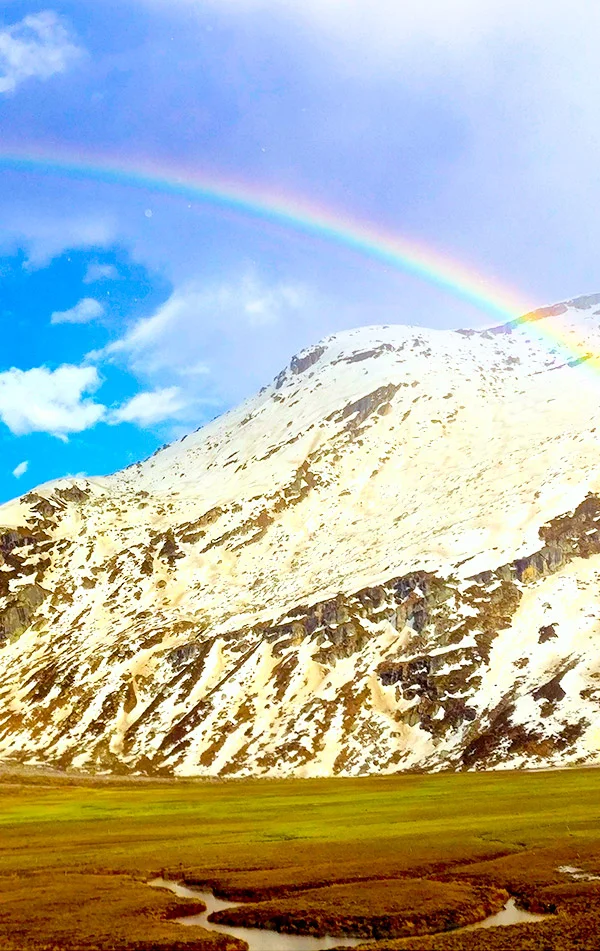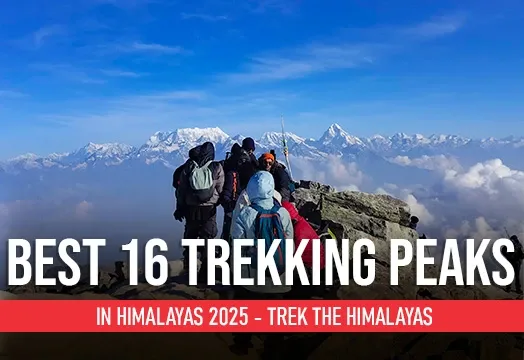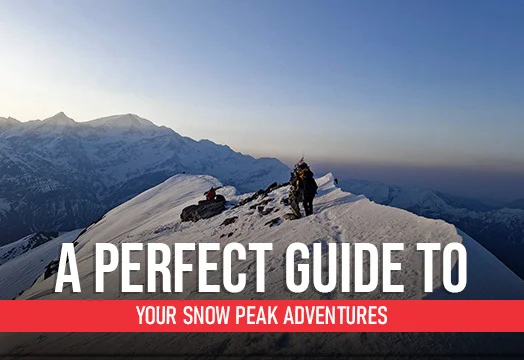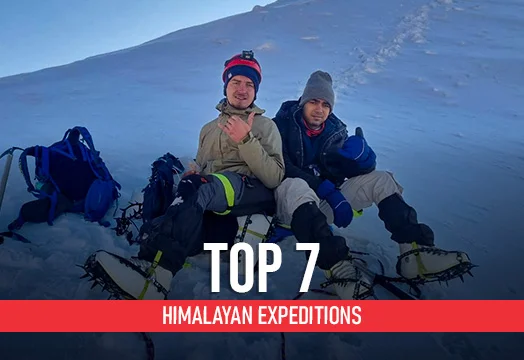Deo Tibba Peak Expedition

Region
Himachal Pradesh | India

Duration
13 Days

Max Altitude
19700 Ft.

Trekking Km
60 KM

Grade
Challenging
Get in Touch with Our Trek Expert
91 8191004846 info@trekthehimalayas.comMonday - Saturday: 10 AM to 09.30 PM (GMT +5:30)
Sunday: 10 AM to 05.30 PM (GMT +5:30)
64500 /Person
- 5% GST will be applicable on Trek Cost and Add-ons
- Services Manali to Manali
Get in Touch with Our Trek Expert
91 8191004846info@trekthehimalayas.com
Monday - Saturday: 10 AM to 06 PM (GMT +5:30)
Overview
Trek Name: Deo Tibba Peak Expedition
Days: 13
Adventure Type: Mountaineering
Base Camp: Manali
Season:Summer | Monsoon |
Month:June |
Country: India
Altitude: 19700 Ft.
Grade: Challenging
Rail Head: Chandigarh is the nearest rail head to the base camp
Stay: Camping (Twin sharing) & Hotel/Guesthouse
Food: Meals while on trek (Veg & Eggs)
Location: Himachal Pradesh
Distance: 60 Km.
Trail Type: Summit, Point to point | Scale a peak, Camping at the same location upon returning.
AirPort: Bhuntar, which is 52 km away from Manali
Highlights:
- 5% GST will be applicable on Trek Cost and Add-ons
- Services Manali to Manali
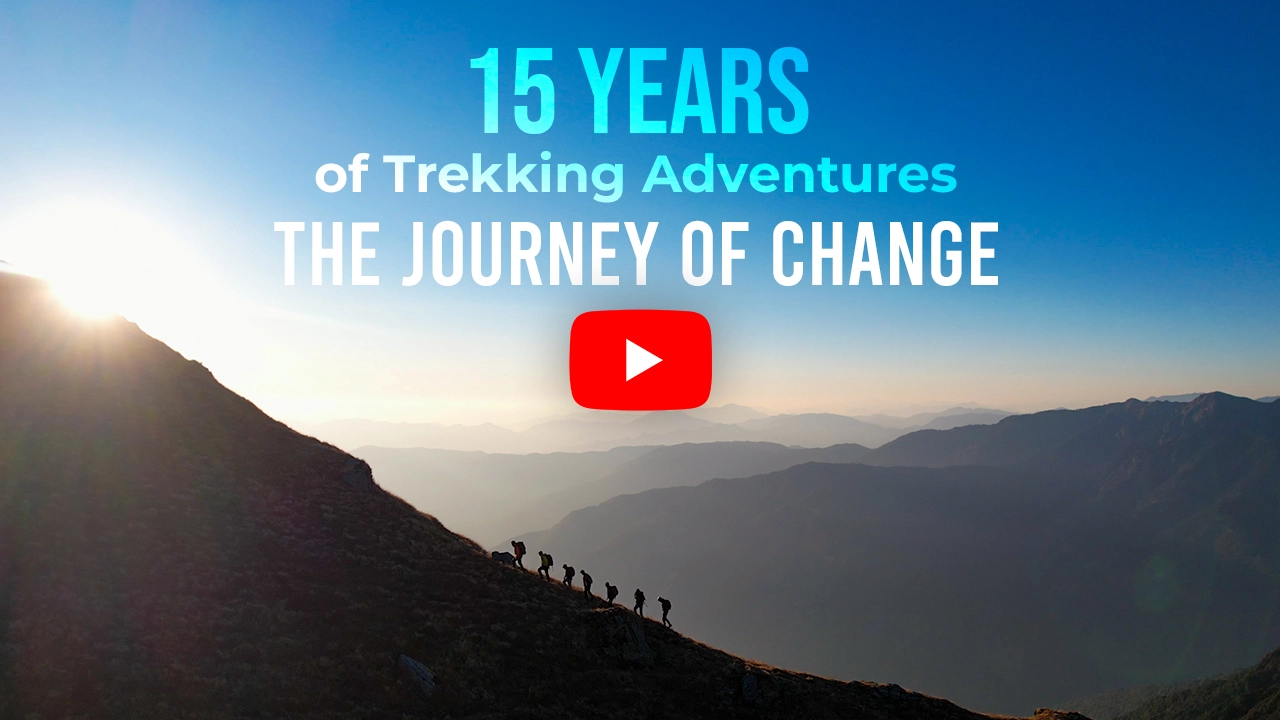
Why Deo Tibba Is A Must-Do Trek?
- Deo Tibba stands as a prominent 6000-meter peak, ranking as the second-highest in the Pir Panjal Mountains.
- Unlike traditional pointed ridges, Deo Tibba's summit surprises with a snow dome, resembling an ice cap.
- The trek unfurls the diverse beauty of Himachal Pradesh, traversing through Jagatsukh village, dense forests, Birch trees, meadows, and glaciers.
- Scenic elements include lakes, waterfalls, and rockfalls, showcasing the rich tapestry of the Himalayas.
- Despite being a 6000-meter peak, Deo Tibba demands mountaineering-style climbing with technical equipment like fixed ropes, crampons, and ice axes.
- Recommended only for seasoned trekkers possessing technical expertise.
- Deo Tibba is a challenging trek, demanding more strength and endurance compared to easier treks.
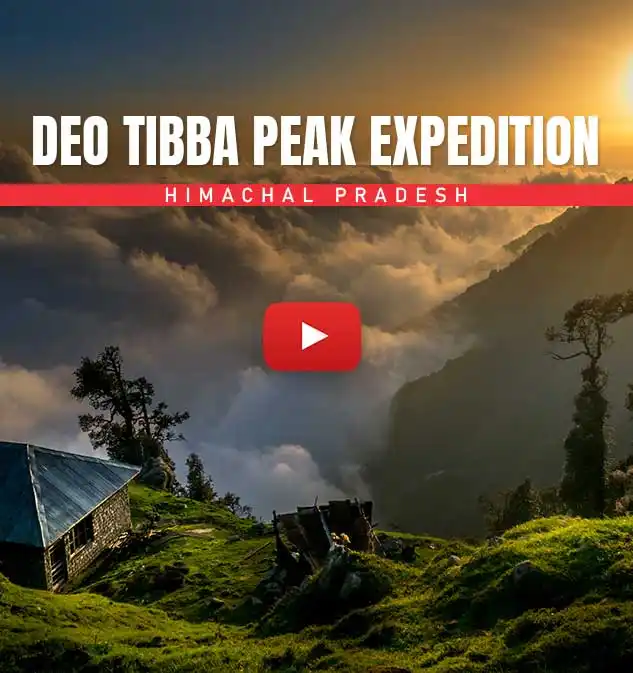
Who Can Participate
- Age Requirement:
- Minimum 18 years
- Experience of at least two high-altitude trek (4,500m- 5,000m) is required. First-timers are advised to avoid this trek.
- Fitness Criteria:
- Trekkers must be able to carry a 10-15 kg backpack, as off-load options are not recommended.
- If a trekker's BMI is more or less than the normal range (18-26), please consult our Trek Coordinator before booking.
Deo Tibba Peak Expedition Itinerary
Arrival at Manali
- Altitude: 2,050 m/ 6,750 ft.
- Check-in at the hotel (CP Plan) (twin/triple sharing).
- Briefing after lunch approx. 12 pm.
- In the evening go sightseeing.
- Visit Hidimba Devi Temple, Vashist Kund, and other major sightseeing points (avoid Rohtang Pass).
- Note: Only hotel stay included in the cost (food and sightseeing are excluded).
Arrive with excitement in the adventure hub, Manali. Get fresh and be ready to explore Manali. Manali is a town located on the banks of the Beas river. It is completely covered with tall Pine trees; the weather is pleasant throughout the year. This rustic enclave offers a beautiful respite for all the tourists who are looking for a break from the monotony of daily lives and the scorching heat of the summers. The glacial waters of the Beas River flowing down from the slopes of Rohtang Pass offer a perfect destination for adventure activities like white water rafting and rowing. On a clear day, you can also see the DeoTibba peak from Manali. You can roam around on Mall Road or visit Hadimba temple (also known as Dhungri temple), and Vashisht Kund. The Vashist village is a sacred village and the locals have a temple dedicated to the sage Vashisht in this temple. Try not to go far or gain height it may hurdle the acclimatization process. Delay your plans of visiting Rohtang pass after the expedition. At night stay in your hotel, give your body adequate rest to begin trekking the next day.
Manali to Chhikka
- Altitude: 3,100 m/ 10,200 ft.
- Altitude gain: 1,050 m/ 3,450 ft.
- Drive Distance: 15 km | Duration: 1 hr.
- Trek Distance: 5 km, 2 to 3 hrs.
- Drive till the local dam at Khanaul via Jagatsukh.
- Enough natural water sources on the way.
- The first 20 minutes is a steep climb.
- Most of the trek is a gradual ascent in alpine forest.
- The last half an hour is on open grasslands.
- Jagatsukh is the old capital of Kullu.
- Chikka is famous for the temple of Nag Devta.
- Stay in the tent (twin-sharing).
Get all ready to begin the first day of your trek. We will pick you up early in the morning post breakfast and refreshments. First, you start with a ride till Sethan and then followed by a small trek to Chikka. Make sure you actively observe the sceneries during the ride. It is wonderful climbing up passing through Jagatsukh. It is one of the beautiful villages with colorful wooden houses. Jagatsukh was old Kullu capital. The road ahead is not that good with bumpy curves. Look at the greenery around as you slowly move away from Manali. The drive from Manali to Sethan is not long but very scenic.
Right before Chikka, you will cross Sethan. It is another popular adventure site, it is famous for rock climbing and snowboarding. You can see the big tunnel doors of the Hydro Power project at even distances. After you have crossed the Khanaul dam get ready to start your trek. The trek route is through dense forests and uphill and it is also filled with different types of berries and flowers. The first 20 minutes are steep then it is a gradual walk through the valley. You will arrive at your campsite in 2-3 hours of the trek. From Chikka, you will get stunning views of Deo Tibba, Indrasan peak, and Spiti Valley. There’s also a beautiful Nag Mandir at the Chika campsite. Enjoy your blissful stay in tents.
Chhikka to Seri
- Altitude: 3,850 m/ 12,600 ft.
- Altitude gain: 750 m/ 2,400 ft.
- Trek Distance: 8 km | Duration: 5 to 6 hrs.
- Moderate level, gradual ascent till Seri.
- Walkthrough forest, meadow, and big boulders.
- Trek is one of the right banks of Jagatsukh Nallah.
- View of Deo Tibba peak.
- Enough water sources on the way.
- Seri campsite is a big green grassland.
- Seri was once a glaciated lake.
- Hot lunch at campsite.
- Stay in tent.
Wake up fresh to start your hike to Seri. The trail starts with a gradual ascent through dense forest. As you move up slowly you may notice the forest cover getting sparse. The trail is throughout on the right of the Jagatsukh Nallah and it is well-marked with stones and cairns. You may also encounter freshwater springs at Panduropa and Dudu Patthar. An hour into your trek and you will cross a stream and a little further from the stream is a small section with boulders. If it has rained recently or raining during the trek then be very careful as these stones tend to get slippery. Once you cross the bouldered section, the climb gets steep, avoid straining your legs a little too much.
The Birch starts welcoming us through the trail followed by bushes. All of which vanishes to open grounds of meadows all of a sudden. These meadows are the grasslands of Seri but the campsite is a little away from here. After about 3 km of trekking, you will arrive at Panduropa, where you will find another bouldered section. Once you cross the bouldered section, your Seri campsite awaits you. You can see Tainta cliffs on the left and waterfalls on these rocks. This campsite is also pleasantly located on flat grounds. Seri once used to be a glacial lake but now it is a meadow that is drained of icy rivulets and now surrounded by greenery and wildflowers. From the campsite, you can see the neighboring cliffs of Jagatsukh, Norbu, Malana Pass, and a part of Deo Tibba peak. Stay overnight at the campsite.
Seri to Deo Tibba Base Camp
- Altitude: 4,500 m/ 14,800 ft.
- Altitude gain: 650 m/ 2,200 ft.
- Trek Distance: 8 km | Duration: 5 to 7 hrs.
- Seri to Deo Tibba Base Camp via Tainta and Chota Chandratal.
- Gradual and steep mixed ascent.
- Two major steep ascents, both are just before Tainta and Chota Chandratal.
- Till Tianta walk is grassland and after that on the moraine.
- Enough water sources on the way.
- According to Hindu Mythology, Dhomya Rishi did meditation at Chota Chandratal.
- A mesmerizing view of Deo Tibba Peak for the base camp.
- Stay in tent.
Today will be a little tough day compared to the previous two. The trek starts with a flat trail as you walk on the Seri grasslands. Keep walking along the Jagatsukh River and you will come across a waterfall, and somewhere nearby you will see a cairn. Cross the river and continue on the trail and you will begin climbing up. The climb is on the zig-zag trail till Tainta cliff and it is extremely steep for about 2-2 ½ hr. Once you cross the Nala or stream moraines start. You will overcome the boulder field. Another hour\'s walk on the ridge and you will be at the Tainta camp which is the base of the glacier.
As you can imagine henceforth the trail is through loose scree. Take your steps carefully. The climb through such a trail is for two hours until you reach Chota Chandratal. It is a tiny lake in the mountain depression. The entire lake is surrounded by wildflowers and the Deo Tibba peak towers beautifully against the lucid blue skies. Once you reach the top it's a flat walk all the way to the campsite. Your camp will be towards the downside of the lake. Unlike the previous two camps, this camp is in a closed valley. Cross the lake and find a suitable spot where you can pitch your tent.
Rest / Acclimatization day
- An acclimatization day at this height is mandatory.
- Explore and enjoy a campsite surrounded by peaks.
- Technical gear distribution.
- Hot lunch at campsite.
- Visit Chota Chandratal After Lunch.
- General Meeting For The Setup Of Camp 1 And Summit Camp.
- Stay In Tent.
Wake up today to chill and rest. Since we have reached 4200 meters in height it is important to give your body the time for acclimatization. On a high-altitude trek, it is extremely crucial to take enough time to acclimatize. If you are rapidly gaining altitude and do not schedule enough time to acclimatize, you put yourself at a higher risk of altitude sickness. This usually happens when a trekker climbs too high too quickly. To avoid such problems, it is essential to slow down and allow your body to adjust. This promotes your body to go through the necessary physiological changes to adjust to the environment and the decreased oxygen intake at higher altitudes. As AMS is not dependent on the age, fitness level, or experience of an individual, it is important for trekkers to take an adequate amount of acclimatization break to adjust to higher altitudes. However, if you do get AMS, our trek leaders are trained to detect and deal with the symptoms of AMS and will provide you with sound advice if you have the symptoms. Also, if you experience signs of AMS, let your trek leader know immediately.
You can roam here and there and explore the campsite. Technical equipment will be distributed and tested by our team. You can try them and clear your doubts. You can visit Chota Chandratal after lunch. In the evening there will be briefing sessions on the summit process and further plans.
Load ferry to Camp 1 (Duhangan Col)
- Altitude: 5,100 m/ 16,800 ft.
- Altitude gain: 600 m/ 2000 ft.
- Trek duration: 4 to 5 hrs.
- Moderate ascent for the first 200 m, steep for the next 300 m, and the last 100 m is gradual.
- Camp 1 is set at the Duhangan Pass.
- Camp 1 is marked by a saffron-colored rock, visible from your base camp.
- The steep slope between 45 to 65 degrees.
- Have to cross Deo Tibba Glacier for set up at Camp 1.
- Glacier is full of open and hidden crevasses.
- Ascent is a mix of snow, rock, and ice, known for rockfalls.
- Load ferry will help participants to be better acclimatized for Day 7.
- Carry enough water.
- Packed lunch for the way.
- Stay in the tent (Deo Tibba Base Camp).
Today will mark your journey into the mountaineering world. In Mountaineering it is important to do a load ferry. It is a term that works on the principle of working at high altitudes and sleeping in low altitudes, where climbers first carry their equipment and gear to the higher camp and rest for the night at base camp. Since the physiological functioning of the body at higher altitudes is different than that on plains, it is important to take the necessary acclimatization measures. The load ferry concept helps for acclimatization and avoids AMS even at higher heights. Today you will be carrying your gear to camp 1 and will come back for the night at the base camp.
The trail is difficult that starts with a moderate ascent for the first 200 m then steep for 300 m followed by a 100 m flat slope. Camp 1 is situated on Duhangan Pass. Uniquely the location of the campsite can be seen from Base Camp also due to saffron-coloured rocks. The slope is between 40 to 65 °C and is filled with snow and rocks. You can see that the glacier starts. There are many crevasses on the glacier so watch your steps. The trail is known for rockfall, therefore, follow your guide and team.
Once you have loaded all the gear have your lunch at camp 1 and get ready to go down. Stay will be in the tents at Base Camp.
Deo Tibba Base Camp to Camp 1
- Altitude: 5,100 m/ 16,800 ft.
- Altitude gain: 600 m/ 2,000 ft.
- Trek Duration: 5 to 6 hrs.
- The entire team will move to Camp 1.
- Leave the base camp early in the morning.
- Give proper rest to your body and keep warm
- Stay in a tent (Camp 1).
Today will be the actual day when you will shift to camp 1 completely. Follow the same route as you did the day before. Be cautious on the rockfall area, glaciers, and while crossing rocks. The climb will take almost 5-6 hours. Make sure you do not exhaust your body and take enough rest. Stay in tents at camp 1.
Load ferry to Summit Camp
- Altitude: 5,600 m/ 18,400 ft.
- Altitude gain: 500 m/ 1,600 ft.
- Trek distance: 4 km | Duration: 4 to 5 hrs.
- Also known as Camp 2.
- Ascent is full of snow.
- The First 1 hr is a gradual ascent, the rest is a steep ascent.
- Snow clothing and crampons are required.
- Spend some time at summit Camp for better acclimatization and back to Camp 1.
- Packed lunch for the day.
- Carry warm water from the campsite.
- Stay in tents (Camp 1).
It is time to move to the summit camp. But again it will only be load ferry and coming back to camp 1. Since we are gaining quite a bit of altitude in a limited time frame, altitude-related sickness is a possibility, which is why the load ferry concept is incorporated again to prevent altitude-related issues and to help your body adjust to the lack of oxygen. The entire trail is filled with snow in today’s trek. Therefore, wearing all the snow gear and clothing is necessary. Due to the presence of the snow, the trail becomes much more difficult.
For the first one hour, it is a moderate climb which later on becomes a steep climb. Be careful and follow your team. Follow the footsteps of your guide as he breaks the route open for you. Spend little time on the summit camp, and have lunch so that your body starts acclimatizing. Again retrace your steps back to camp 1. Stay the night in Camp 1 and rest your body well.
Camp 1 to Summit Camp
- Altitude: 5,600 m/ 18,400 ft.
- Trek duration: 4 to 5 hrs.
- Altitude difference: 500 m/ 1,600 ft.
- The entire team will move to Summit Camp.
- Leave all the unnecessary things at the Camp.
- Final summit briefing.
- Stay in tents (summit camp).
Today, the entire team will move to summit camp. Carry only minimal items that will be needed and leave the rest at camp 1 only. Follow the same as the day before. Since high-altitude climbing requires a proper acclimatization routine so expeditions usually employ the method of load ferry or making rounds between the camps to better adapt to the conditions. ‘Climb high and sleep low’ is a golden rule in such cases if you want to survive and successfully complete the expedition. For Deo Tibba, we make two rounds of the campsites, first during the load ferry when we move our stuff to Camp 1 and return to the lower campsite and again from Camp 1 and summit camp and back to Camp 1. This has many benefits. First, you divide the weight between two days so that you do not have to carry a massive weight during the trek. Second, it gives your body adequate time to adjust to the high altitude conditions, and lastly, each time you climb the same route, it becomes easier and also refines your techniques and skills.
Once you reach the camp, your team will brief you about the summit attempt. It’s a good time to brush up on the snow and ice skills. The night will be exciting as it will be the summit night. Eat full and rest properly for the summit attempt.
Summit Attempt and back to Camp 1
- Altitude: 6000 m/ 19,700 ft.
- Altitude gain: 400 m/ 1,300 ft.
- Trek Distance: 6 km | Duration 4 to 6 hrs.
- Recheck all equipment.
- Summit attempt at 2-3 am in the morning.
- Fixed rope required through the gully.
- The First 300 m/ 1,000 ft is a steep and technical ascent.
- The last 100 m/ 300 ft is easy to walk on the dome.
- Indrasan peak is clearly visible.
- Summit is a giant snow dome.
- The final ascent to the peak has a few crevasses.
- Just before the summit, the slope becomes. steeper.
- Summit is wide and can accommodate all team members.
- After the summit attempt wind up the summit camp and back to Camp 1.
- Reach Camp 1 in the early evening.
- Stay in a tent (Camp 1).
The summit attempt will start at 2 am in the early morning. Wake up accordingly to get all geared up for the summit push. Recheck all your equipment and be prepared. The route starts by crossing a gulley using fixed ropes. The First 300 m is a steep and technical ascent.
Keep climbing up on the snow slopes. You can see the Indrasan Peak as you gain height. The slope gets steeper right before the summit. The summit is actually a big snow dome, open and flat. Hence, the last 100 m to the summit is almost a flat walk. There are also many crevasses towards the end. While climbing to the summit after crossing the gully is manageable but the real challenge is the thinning air as you constantly gain altitude.
The summit is wide open that can accommodate all the team members. When you arrive at the summit you can clearly see Indrasen peaks and a mountain lake. The views are absolutely stunning. If in any cases summit push gets halted then buffer days will be used. After the summit attempt, spend a little time at the summit, bask in your sense of accomplishment and come back to camp 1.
Camp 1 to Deo Tibba Base Camp
- Altitude: 4,500 m/ 14,800 ft.
- Altitude loss: 600 m/ 2,000 ft.
- Trek Distance: 3 km | Duration: 3 to 4 hrs away.
- Steep descent all the way.
- Reach Base Camp by afternoon.
- Return all the technical equipment given by TTH.
- Stay in tent.
After the summit attempt, it is now time to start the return journey. Follow the same trail to DeoTibba Base Camp. It is a steep descent, therefore, watch your steps. Descending can be a little tough on the knees so be careful and maintain a steady pace. The terrain also has boulders, moraines and rocks so be a little careful. Try to reach the Base Camp by lunchtime. Return all your technical equipment to your Trek Leader. Rest after the strenuous days in your tents.
Base Camp to Chhikka
- Altitude: 3,100 m/ 10,200 ft.
- Altitude loss: 1,400 m/ 4,600 ft.
- Trek Distance: 16 km, Duration: 6 to 8 hrs.
- Mixed steep and gradual descent.
- Packed lunch on the way.
- Stay in tent.
Start your return journey back home. Retrace your steps through steep trails and moraines. The path is gradual and flat in between. Essentially, you will be walking down the same steps that you came in The trail will be 14 km long hence carry your packed lunch. Enjoy your last tent stay at Chika.
Chikka to Manali
- Altitude: 2,050 m/ 6,750 ft.
- Altitude loss: 1,050 m/ 3,450 ft.
- Trek distance: 5 km | Duration: 2 to 3 hrs.
- Drive distance: 12 km | Duration: 1 hr.
- Reach Manali by lunch.
- Stay is not included in cost.
The last day of the trek has arrived. The last day is all about tracing your steps down through the same route that you came up with initially. Collect all the memories and say goodbye to the mountains. Follow the same trekking trail, all the way to Khanaul, and then ride back to Manali. The trek and drive included will take a few hours and you will reach Manali by lunchtime. Celebrate the joys of your achievement and have a safe journey home!
Day-1: Arrival at Manali
- Altitude: 2,050 m/ 6,750 ft.
- Check-in at the hotel (CP Plan) (twin/triple sharing).
Day-2: Manali to Chhikka
- Altitude: 3,100 m/ 10,200 ft.
- Drive Distance: 15 km | Duration: 1 hr.
- Trek Distance: 5 km, 2 to 3 hrs.
Day-3: Chhikka to Seri
- Altitude: 3,850 m/ 12,600 ft.
- Trek Distance: 8 km | Duration: 5 to 6 hrs.
Day-4: Seri to Deo Tibba Base Camp
- Altitude: 4,500 m/ 14,800 ft.
- Trek Distance: 8 km | Duration: 5 to 7 hrs.
Day-5: Rest / Acclimatization day
- An acclimatization day at this height is mandatory.
- Explore and enjoy a campsite surrounded by peaks.
Day-6: Load ferry to Camp 1 (Duhangan Col)
- Altitude: 5,100 m/ 16,800 ft.
- Trek duration: 4 to 5 hrs.
Day-7: Deo Tibba Base Camp to Camp 1
- Altitude: 5,100 m/ 16,800 ft.
- Trek Duration: 5 to 6 hrs.
Day-8: Load ferry to Summit Camp
- Altitude: 5,600 m/ 18,400 ft.
- Trek distance: 4 km | Duration: 4 to 5 hrs.
Day-9: Camp 1 to Summit Camp
- Altitude: 5,600 m/ 18,400 ft.
- Altitude difference: 500 m/ 1,600 ft.
Day-10: Summit Attempt and back to Camp 1
- Altitude: 6000 m/ 19,700 ft.
- Trek Distance: 6 km | Duration 4 to 6 hrs.
Day-11: Camp 1 to Deo Tibba Base Camp
- Altitude: 4,500 m/ 14,800 ft.
- Trek Distance: 3 km | Duration: 3 to 4 hrs away.
Day-12: Base Camp to Chhikka
- Altitude: 3,100 m/ 10,200 ft.
- Trek Distance: 16 km, Duration: 6 to 8 hrs.
Day-13: Chikka to Manali
- Altitude: 2,050 m/ 6,750 ft.
- Trek distance: 5 km | Duration: 2 to 3 hrs.
Deo Tibba Peak Expedition Graph
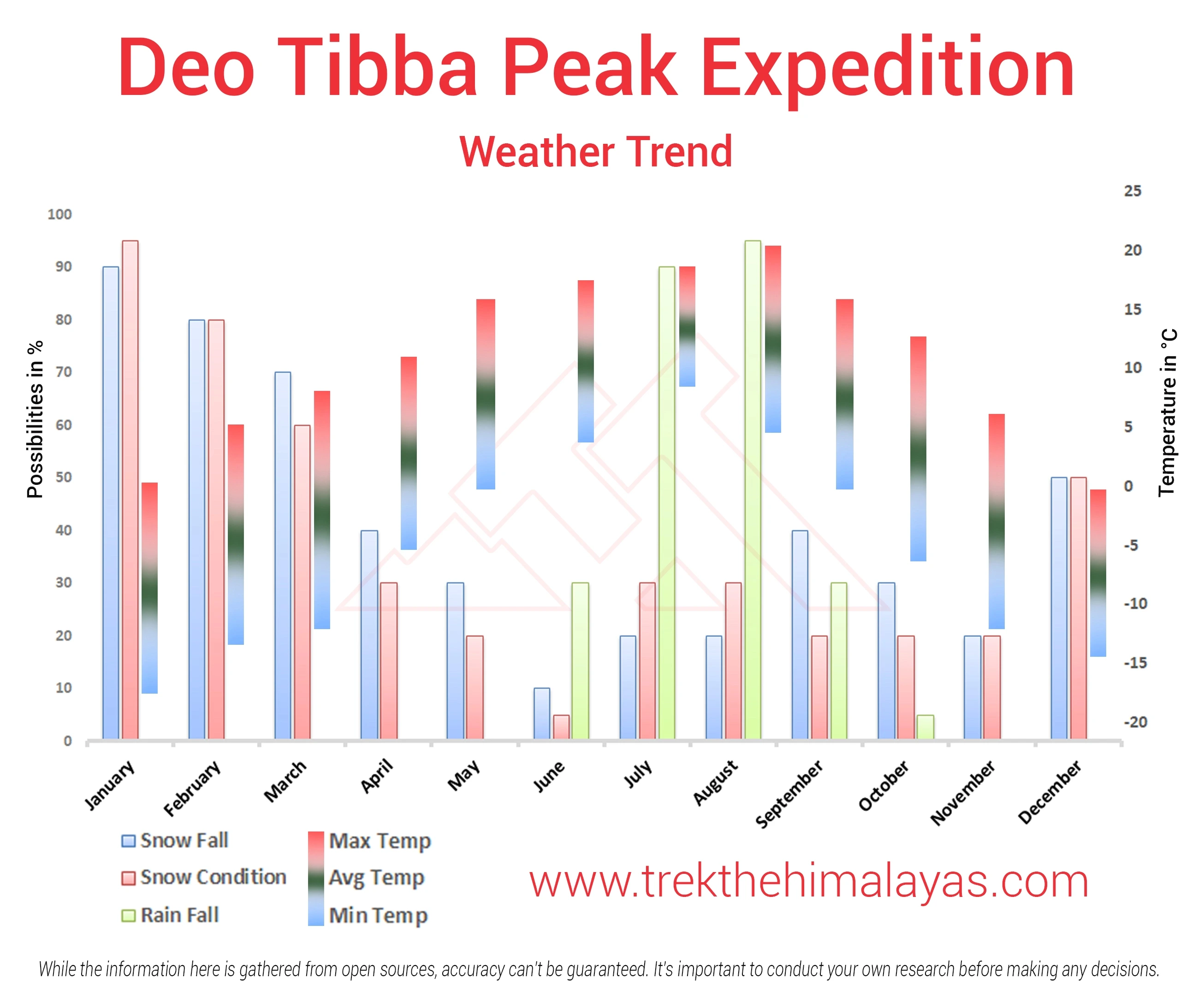
.webp)
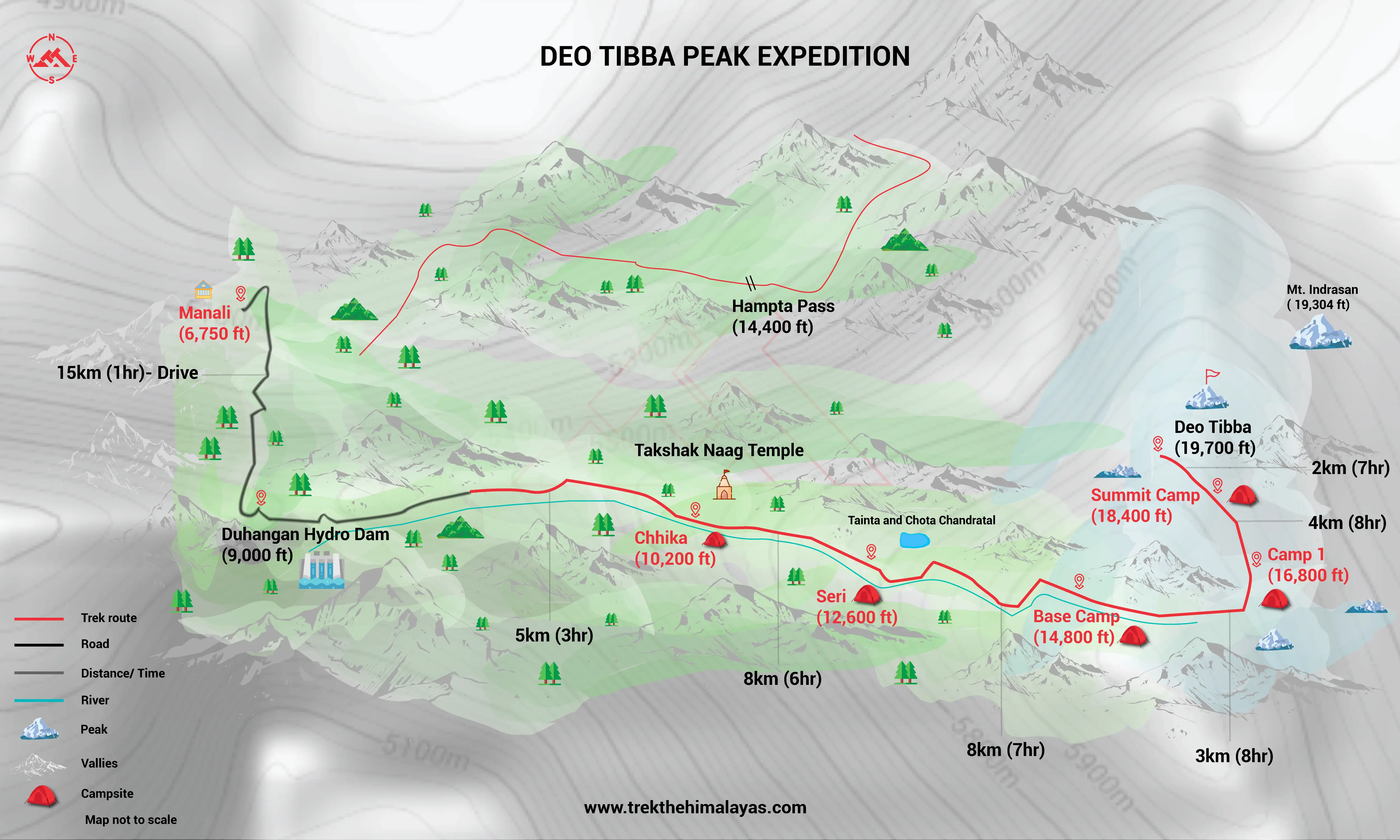
- Pulse rate at rest must be in between (60 to 100 beats per minute).
- Blood Pressure Reading must be in between (DIASTOLIC 75 – 85, SYSTOLIC 100 - 130 mm Hg).
- Respiratory rate at rest must be in between (12 to 20 breaths per minute).
- Should not have Liver and kidney issues.
- Should not have Diabetes Mellitus, Bronchial Asthma, Heart problems, Hypertension, etc.
- No pacemaker implant.
- People with Sinus issues, Epilepsy please contact to trek coordinator before booking the trek.
- If your BMI is not normal, Please contact our Trek coordinator before Trek booking.
Medical & Disclaimer Form (Mandatory Documents) Click here to download Medical & Disclaimer Form
Government employees can avail the benefit of Special Casual Leave (SCL) when they join us for a trekking expedition. As per Pay Commission guidelines, up to 30 days of Special Casual Leave can be availed in a calendar year for trekking or mountaineering expeditions conducted through a registered organisation.
Trek The Himalayas is a registered adventure tour operator with the Indian Mountaineering Foundation (IMF) and the Ministry of Tourism (MoT), making your trek eligible for SCL benefits.
To apply, email us at info@trekthehimalayas at least 20 days before the trek departure date, with the following details:
- Trek name and trek date
- Booking details
- Full name
- Designation
- Department and department address
This benefit is exclusive to Indian Government employees and is applicable only for treks within India.
- Junior trekkers (below 15 years) should have a company of parents/guardians.
- Trekkers between 15 to 18 years can come solo with the disclaimer form signed by parent/guardian.
- Medical & Disclaimer Form (Mandatory Documents) Click here to download Medical & Disclaimer Form
Important Links
- Mandatory Documents to Bring on A Trek Click Here.
- How to pay Add-ons, Submit Medical Forms, and Dietary Preferences Click Here to watch Video
How To Reach
Pick UP Information
- Once you have reached the assembly point of the trek in Manali, TTH will manage the rest of your travel arrangements, if you have opted for TTH's pick-up service, you can select this option during the booking process by adding it as an add-on.
Options to Reach Manali
First, you can arrive at Chandigarh, Delhi, Pathankot, or Bhuntar airport. The journey from these locations to Manali is explained below.
1. Take an overnight bus to Manali from Delhi or Chandigarh, taking a bus from Chandigarh is the most ideal option.
- Chandigarh to Manali Bus: 10 hours.
- Delhi to Manali Bus: 14 hours is hectic and takes more time.
( We always recommend going for the govt. Buses over the private ones outside the bus station as based on the experience we have found that there are very high chances of delay involved with private buses. Also, govt. Buses are always more reliable. Whichever bus you choose, just make sure to reach Manali at 10 am. )
2. You can take a flight to Bhuntar Airport (but we would not recommend it because of the high prices of the flight and very high chances of cancellations), Manali is just a couple of hours away and you can easily get a bus or a private taxi till there. If you do plan to come via Bhuntar, make sure to reach at least a day before the trek starts.
3. You can even come via train, Chandigarh railway station is from where you can get direct buses to Kullu/Kasol/Manali that is 275 km from there and would take an overnight journey. Even in this case, reach a day before at Manali.
( If you prefer to travel independently, you can either take a government bus or book a private cab. Your trek coordinator will provide guidance on how to arrange for the bus or cab booking.)
Drop-Off Information
- The designated drop-off point is the Manali Gov bus stand around 6:30 pm to 7:30 pm .
- Please consider planning your subsequent travel arrangements after 8:00 pm.
- It's highly advisable to keep a buffer day in your travel plan. If the buffer day is not needed, it can be used to explore Manali.
- TTH offers comfortable transportation through Tempo Traveler, Bolero, or equivalent vehicles. If you wish to upgrade your mode of transportation, please contact your trek coordinator for further assistance.
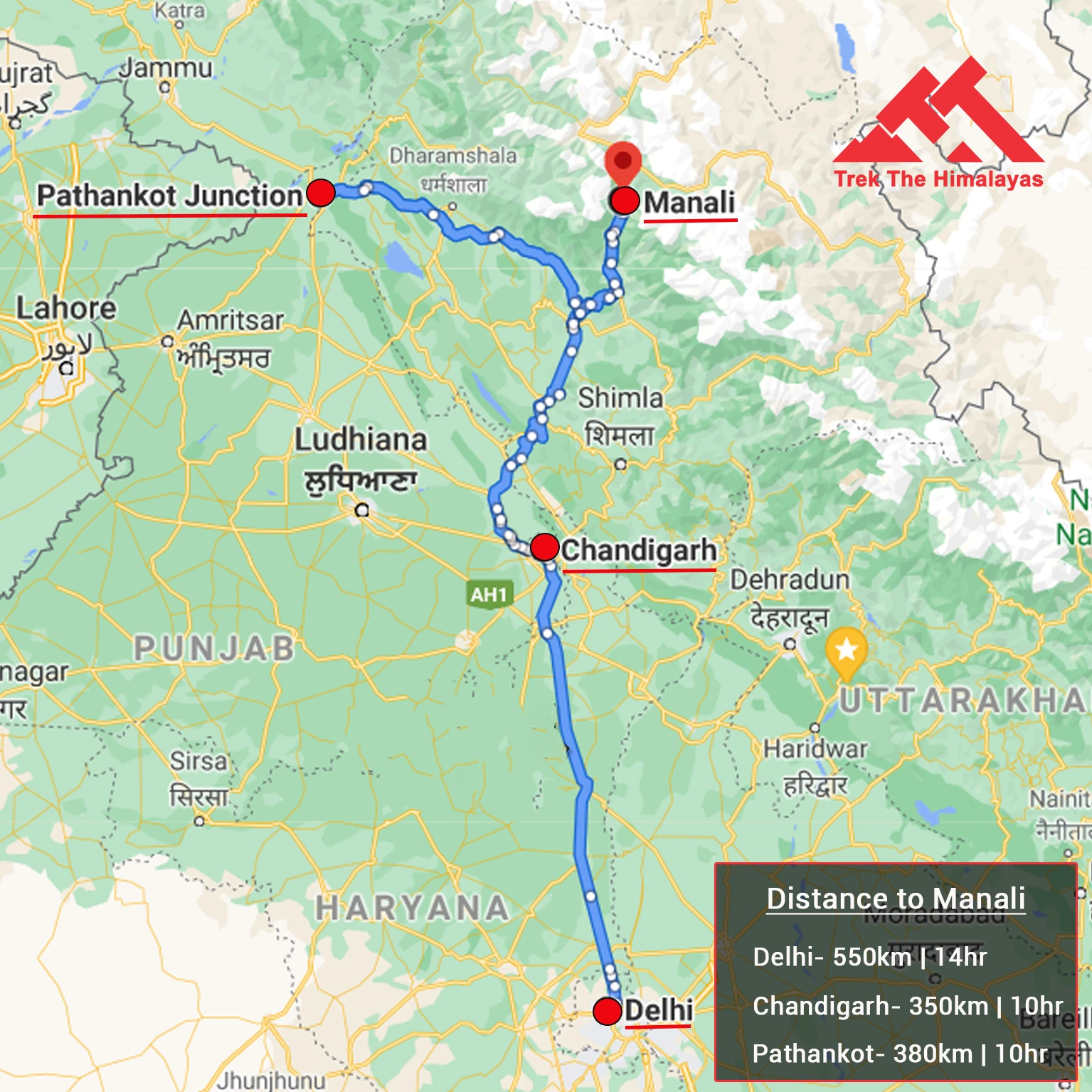
Cost Terms
Inclusion
1. Accommodation (as per the itinerary):
- Guest houses on Day 1 (twin/triple sharing basis).
- Camping during the trek (Day2 to Day 12).
2.Meals (Veg + Egg):
- All meals while trekking.
- Day 2 Lunch to Day 13 Lunch.
3.Transportation (as per the itinerary):
- Manali to Khanaul (Day 2).
- Khanaul to Manali (Day 13).
4. Support:
- 1 Versatile base camp manager: handles communication and deploys extra manpower in emergencies.
- 1 Mountaineering & First aid qualified professional expedition Leader.
- 1 Experienced high altitude chef.
- Local experienced guides (Number of guides depending on the group size).
- Enough support staff.
5. Trek equipment:
- Sleeping bag, Sleeping liners (if required), Mattress, Utensils.
- 3 men all season trekker tent (twin sharing), Kitchen & Dining tent, Toilet tent.
- Camping stool, Walkie talkie.
- Ropes, Helmet, Ice axe, Harness.
- Climbing Boots, Gaiters & Crampon.
6. First aid:
- Medical kit, Stretcher, Oxygen cylinder, Blood pressure monitor, Oximeter, Stethoscope.
7. Cloakroom service at base camp.
8. Mules/porters to carry the central luggage.
9. All necessary permits and entry fees, Upto the amount charged for Indian.
10. Services from Manali to Manali.
11. Trek completion certificate from TTH.
Exclusion
- Insurance (Mandatory).
- Food during the transit.
- Any kind of personal expenses.
- Mule or porter to carry personal luggage.
- Emergency evacuation, hospitalization charge, etc.
- Any extra costs incurred due to extension/change of the itinerary due to natural calamities roadblocks, vehicle breakdown, etc. factors beyond our control
- Transportation (Rishikesh to Sari village & Baniyakund to Rishikesh, if not booked)
- Anything not specifically mentioned under the head Inclusion.
Things can be provided on demand and availability (participant has to pay extra for these things).
1- Satellite phone/set phone - is a type of mobile phone that connects via radio links via satellites orbiting the Earth instead of terrestrial cell sites like cellphones. Therefore, they can operate in most geographic locations on the Earth's surface.
2- Gamow/PAC HAPO Bag (Portable Hyperbaric Bag) - is a unique, portable hyperbaric chamber for the treatment of acute mountain sickness (AMS), also known as altitude sickness.
3- AEDs (Automated External Defibrillators) - are portable life-saving devices designed to treat people experiencing sudden cardiac arrest, a medical condition in which the heart stops beating suddenly and unexpectedly.
Cancellation Terms
To request a cancellation, please email us at info@trekthehimalayas.com using your registered email ID.
Cancellations prior to 25 days from the start of the Trip
Refund Options
- 5% deduction of trek fee
- 100% trek fee cash voucher for any trip till one year
- Transfer your trek (any trek, any date) to your friend
Cancellation between 24 days and 15 days to the start of the Trip
Refund Options
- 30% deduction of trek fee
- 100% trek fee cash voucher for same trip till one year
- 85% trek fee cash voucher for any trip till one year
- Transfer your trek (same trek, any date) to your friend
Cancellation between 14 days and 10 days to the start of the Trip
Refund Options
- 50% deduction of trek fee
- 80% trek fee cash voucher for same trip till one year
- 70% trek fee cash voucher for any trip till one year
- Book the same trek, in the same season, with any other batch
- Transfer your trek (same trek, any date) to your friend
Cancellation less than 9 days to the start of the trek.
Refund Options
- No cash refund
- 20% trek fee cash voucher for the same trip till one year
- 10% trek fee cash voucher for any trip till one year
- Transfer your trek (same trek, same date) to your friend
- To reschedule a trek (same trek only), a 30 % rescheduling fee of the trek cost will apply.
Cancellation Policy (Emergency Cases):
In case of a death in the immediate family (parents, siblings, spouse, children) or if the trekker is hospitalized (min. 48 hours) or suffers a fracture (leg/arm) within a week before the trek, even if canceled a day before:
90% trek fee refund in cash & 10% as a voucher (valid for 1 year, for any India trek).
Valid documents required. We’re here to support you during tough times.
Note:
- Change of trek batch is dependent on the availability of seats in the batch
- In case of transferring a trek to a friend, he/she should satisfy all the mandatory requirements put forward by TTH
- TTH holds the right to change/cancel the policies, without prior notice
Booking and Payments
- The Participant is responsible for verifying the accuracy of all details, including Trip dates and personal documentation, at the time of booking.
- Payments must be made in accordance with the timelines and instructions provided by TTH. Late payments may result in cancellation of booking without refund.
- In the event of a cash refund, only the portion of the payment made in cash shall be eligible for refund in cash. Any booking made using voucher, discounts, promotional codes, or through any non-cash mode of payment shall not be eligible for a cash refund under any circumstances.
- Refunds, if applicable, shall be processed within 15–30 working days of confirmation.
- All add-on bookings are subject to the respective add-on cancellation policy, and refunds will be processed accordingly.
- Voucher Terms
- This is a non-transferable voucher
- The voucher cannot be merged with any other offer of Trek The Himalayas
- The voucher is valid for Trek booked directly with Trek The Himalayas in India
- To avail the voucher please use your register phone number or e-mail id
- All the other Terms of booking a trek with Trek The Himalayas are applicable to the voucher
Itinerary and Modifications
- TTH reserves the right to modify, shorten, or cancel any part of the Trip due to transportation delays, weather, health emergencies, or other unforeseen circumstances including Force Majeure.
Cancellations and Refunds
- No refunds or vouchers, partial or otherwise, shall be provided for voluntary withdrawal, non-utilisation of services, or removal from the Trip.
- If TTH cancels the Trip before arrival at the designated pick-up point due to unforeseen circumstances or Force Majeure, the Participant may choose from:
- An alternate Trip/date.
- A credit voucher valid for one (1) year.
- Transfer to another Trip, with cost differences payable by the Participant.
- If the Trip is abandoned post-arrival at the designated pick-up point, no cash refund or voucher shall be issued. The Trek Again Policy may apply at TTH’s discretion.
- TTH shall not be liable for any associated travel costs such as flights, accommodation, or visa fees.
Force Majeure
- Events beyond its control including but not limited to earthquakes, landslides, strikes, curfews, war, pandemic, government restrictions, heavy rainfall or snowfall, windstorms, road blockages, trail disruption, or withdrawal of permits, TTH shall not be held liable for any cancellation, delay, or service modification caused by Force Majeure.
Trek Essentials
Rent EquipmentPDF Of Trek Essential Download
| Backpack with rain cover | (50 - 60 ltr) with comfortable shoulder straps |
| Day pack with rain cover | 20 - 30 ltr (If off-load opted) |
| Walking stick | Advisable (At least one) |
| Water Bottle / Hydration pack | 2 bottles of one liter each, People who use hydration pack 1 hydration pack and 1 bottle of one liter, Carry at least one thermos flask. |
| Small size tiffin/lunch box | 1 Nos |
| Snacks | Energy bars, dry fruits, electral/ors |
| Personal Medical Kit | Consult your doctor |
| T-Shirt (Synthetic quick dry) | 1 Full & 2 Half sleeves |
| Fleece T-shirt | 1 Nos |
| Fleece jacket | 1 Nos |
| Windproof Jacket | 1 Nos |
| Down feather / Hollow jacket | 1 Nos |
| Thermal inner (Upper and Lower) | 1 Pair |
| Trek Pant (Synthetic quick dry) | 2 Nos |
| Fleece Pant | 1 Nos |
| Waterproof gloves | 1 Pair |
| Fleece / woollen gloves | 1 Pair |
| Poncho / waterproof Jacket and pant | 1 Nos |
| Sunscreen | 1 Nos |
| Moisturiser | 1 Nos |
| Chap-stick / Lip balm | 1 Nos |
| Toothbrush and toothpaste | 1 Nos |
| Toilet paper & Wipes | 1 Nos |
| Soap / hand sanitizers | 1 Nos |
| Antibacterial powder | 1 Nos |
| Quick dry towel | 1 Nos |
| Head torch | 1 Nos. (Avoid Hand torch) |
| Sun Cap | 1 Nos. |
| Woolen cap | 1 Nos. |
| Balaclava | 1 Nos. |
| Buff / Neck-gaiters | 1 Synthetic & 1 Woollen |
| Sunglasses | UV with dark side cover, People who wear spectacles - (A)- Use contact lenses | (B)- Photo chromatic glasses |
| Trekking shoes | 1 Pair (Waterproof, high ankle, good grip) |
| Floaters / flip-flops | 1 Pair |
| Cotton socks | 7 pairs |
| Woollen socks | 2 pairs |
| Gaiters | 1 Pair (TTH provides when required) |
| Micro spikes | 1 Pair (TTH provides when required) |
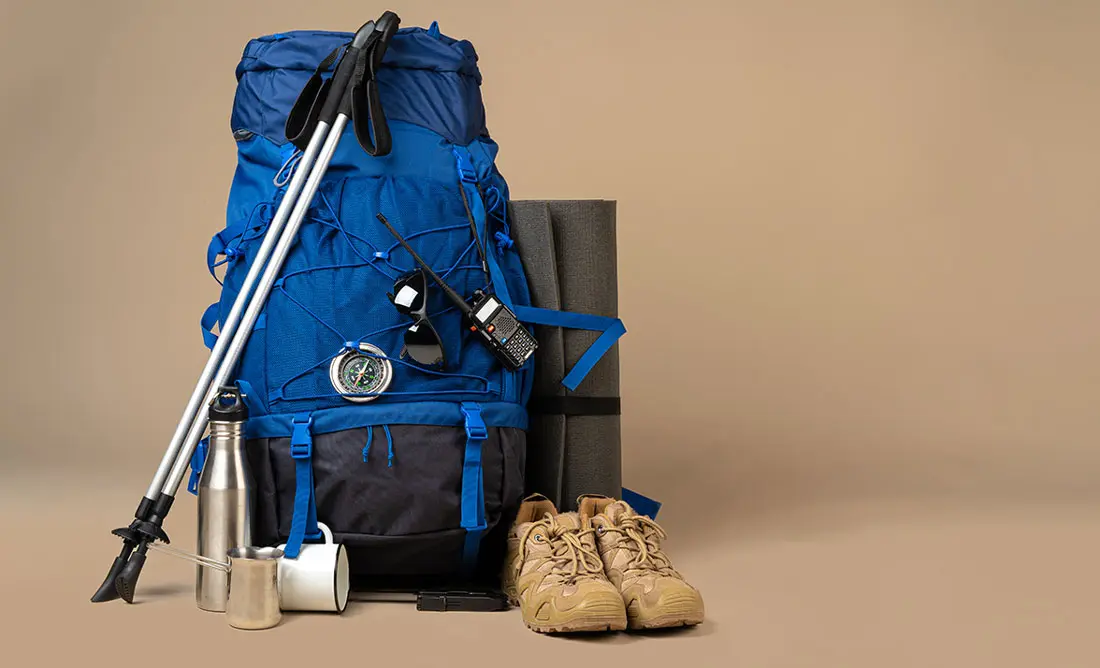
Frequently Asked Questions(FAQ)
To register with TTH, visit our website - www.trekthehimalayas.com and create your account. To create your account you will need to use your email address and fill in all the details, set your unique password and your account is ready to use.
- To book a trek with TTH, you first need to register with us and create an account.
- Choose the trek that you want to do and click on available dates.
- You will land at the login page, fill in the required details.
- Add Participants, choose add-on services click on the Pay now button, choose your preferred payment method, and make the payment. TTH accepts multiple payment options, including credit/debit cards, net banking, and UPI.
- You will receive a confirmation email from TTH with all the necessary details about the trek, including the meeting point, transportation, accommodation, and other important instructions.
- Click Here to watch Video
please send an email to us at info@trekthehimalayas.com or reach out to the numbers provided in the Help and Support section of your Trek Page. We will ensure that your issue is promptly resolved.
To book services such as off-load luggage and transportation, you can find them listed as add-ons. These additional services can be booked at the time of your initial booking. If you miss booking add-ons during the initial reservation, you can log in anytime and easily book 4 days before the departure date add-ons through the platform.
If you have booked the wrong trek or selected the wrong date, don’t worry! You can contact us at +91 9368882322 (Monday to Saturday, 10 AM to 10 PM) or email us at info@trekthehimalayas.com. You can also discuss this with your trek coordinator. Please make sure to inform us at least 10 days before the departure of your trek. Only then can we help you reschedule or arrange another trek for you.
We recommend visiting our "Suggest Me a Trek" page. By filling out the form, our experts will contact you with the best possible trek options based on your preferences and experience level. Alternatively, you can reach out to us via email at info@trekthehimalayas.com or give us a call using the numbers provided on our website for personalized assistance and recommendations.
Family treks differ from regular treks by focusing on ease of difficulty, offering shorter durations for younger participants, Kid-friendly and easily digestible foods, child-friendly activities, maintaining a higher guide ratio for diverse age groups, and implementing additional safety measures for families.
Family Trek with Kids recommendation Only Dayara Bugyal and Chopta Chandrashila Trek.
Minimum age for TTH treks is typically 7 years, though this may vary depending on the specific trek.
Yes, you can take a kids to a high-altitude trek with a parent. Discuss with a trek expert before booking a trek.
- Junior trekkers (below 15 years) should have a company of parents/guardians.
- Trekkers between 15 to 18 years can come solo with the disclaimer form signed by parent/guardian.
- Medical & Disclaimer Form (Mandatory Documents) Click here to download medical and disclaimer form
Physical Fitness: Ensure your child is physically fit. Engage them in regular exercise, outdoor activities, and hikes to build stamina and endurance. Hydration: Emphasize the importance of staying hydrated at high altitudes. Encourage your child to drink water regularly, even if they don't feel thirsty. Proper Nutrition: Provide a well-balanced diet with sufficient carbohydrates for energy and foods rich in iron to prevent altitude sickness. Adequate Sleep: Ensure your child gets enough sleep in the days leading up to the trek. Quality rest is crucial for altitude adaptation. Educate on Altitude Sickness: Teach your child about the symptoms of altitude sickness, such as headache, nausea, and dizziness. Encourage them to communicate any discomfort immediately. Appropriate Clothing and Gear: Dress your child in layers to adjust to changing temperatures. Ensure they have appropriate trekking gear, including sturdy footwear. Positive Mindset: Foster a positive mindset. Encourage your child, and let them know it's okay to take breaks when needed. Medical Check-Up: Schedule a medical check-up before the trek to ensure your child is fit for high-altitude activities. Consult with a healthcare professional about any potential health concerns.
TTH takes special care to provide wholesome and nutritious food for children on treks. Here are some of the foods that are typically served for children:
Breakfast: For breakfast, TTH serves a variety of options like porridge, cornflakes, bread, butter, jam, honey, boiled eggs, omelettes, and pancakes. Children can choose from these options to fuel themselves for the day's trek.
Lunch: For lunch, TTH serves lunch which includes rotis, vegetables, rice, dal, and salad. The rotis are usually made fresh on the trek and are a good source of carbohydrates. The dal and vegetables provide protein and other essential nutrients.
Snacks: TTH provides healthy snacks like fresh fruits, dry fruits, energy bars, cookies, and biscuits to keep the children energized throughout the day.
Dinner: For dinner, TTH serves a hot and wholesome meal which includes soup, rice, dal, vegetables, and a non-vegetarian dish (if requested in advance). Children can also choose from a variety of desserts like custard, jelly, and fruit salad.
Dietary requirements: If a child has any special dietary requirements, TTH can cater to those needs as well. For example, if a child is lactose intolerant or allergic to nuts, the kitchen staff can make arrangements to accommodate those requirements.
Choosing the right trek for a beginner can be a bit overwhelming as there are many factors to consider such as distance, elevation gain, terrain difficulty, weather, and time of year. Here are some tips that can help you choose the right trek for a beginner:
1. Determine fitness level: Assess the fitness level of the beginner to understand their physical capabilities. This will help you select a trek that is challenging but not too difficult.
2. Choose a well-traveled trail: A well-traveled trail will have more amenities such as signposts, water stations, and shelter. It is also safer as there will be other hikers on the trail.
3. Consider the length of the trek: For beginners, it is recommended to start with a shorter trek that can be completed in a day or two. This will help them get acclimatized to trekking and build their confidence.
4. Look for gradual elevation gain: Choose a trek with a gradual elevation gain rather than steep ascents. This will make the trek easier and more enjoyable.
5. Check the weather: Check the weather forecast before selecting a trek. Avoid treks during the monsoon season or winter when the trails can be slippery or dangerous.
6. Research the trail: Read about the trail to get an idea of the terrain, altitude, and difficulty level. This will help you select a trek that is suitable for the beginner.
7. Consult with an expert: If you are unsure about which trek to choose, consult our trek expert Mr. Nitin (+91 70600 59773) between 10 AM to 6 PM (Tuesday - Friday). Mr. Nitin will provide you valuable advice and guidance.
Overall, it is important to choose a trek that is enjoyable, challenging but not too difficult, and suitable for the beginner's fitness level and experience.
It is not recommended for a beginner to choose a difficult Himalayan trek. Trekking in the Himalayas can be physically and mentally challenging, especially if you are not used to the high altitude, steep slopes, and rugged terrain. Choosing a difficult trek without the proper experience, fitness level, and preparation can be dangerous and put you at risk of altitude sickness, injury, and other hazards.
If you are a beginner, it is recommended to start with an easier trek and gradually build up your skills and experience. This will help you understand the challenges of trekking in the Himalayas, and also prepare you physically and mentally for a more difficult trek in the future. It is also important to choose a trek that matches your fitness level, experience, and interest.
There is no specific age limit for a beginner trekker. However, it is important to consider your physical fitness, health condition, and personal interests before embarking on a trek. Trekking in the Himalayas can be physically and mentally demanding, and requires a certain level of physical fitness and endurance.
If you have any pre-existing medical conditions or are above a certain age, it is recommended to consult with a doctor before embarking on a trek. It is also important to listen to your body and take breaks as needed during the trek to prevent exhaustion or injury.
We recommend visiting our "Suggest Me a Trek" page. By filling out the form, our experts will contact you with the best possible trek options based on your preferences and experience level. Alternatively, you can reach out to us via email at info@trekthehimalayas.com or give us a call using the numbers provided on our website for personalized assistance and recommendations.
Yes, you can join the trek. We have fixed departure groups where you can simply book your trek and we will take care of curating a group.
Before you start the trek, it is recommended that you make all the necessary phone calls as during the trek you may or may not receive network coverage, once you come back to the Base Camp, you can reconnect with your family via phone once again. You can share your trek coordinator contact detail with your family members to get the latest updates about your trek batch.
At TTH, we provide wholesome and nutritious meals during the trek. The food is vegetarian and includes a variety of dishes such as rice, dal, vegetables, chapati, paratha, pasta, noodles, and soup. We also offer snacks such as biscuits, and salty, and dry fruits during the trek. Special dietary requirements such as vegan, gluten-free, or Jain food can also be arranged if informed in advance.
If you are allergic to some foods, you need to let us know in advance so that we can make arrangements accordingly.
TTH is a trekking company that prioritizes the safety of all its participants, including women trekkers. We have a comprehensive safety system in place, which includes a dedicated team of experienced and trained trek leaders and support staff who are equipped to handle emergency situations and provide first aid.
TTH also takes specific measures to ensure the safety and comfort of women trekkers. They have a separate tent accommodation for women trekkers, female trek leaders, and support staff. They also provide separate toilet facilities for women and encourage a safe and respectful environment for all trekkers.
Moreover, TTH has a strict policy against any kind of harassment and has a zero-tolerance policy towards such incidents. They have a designated Internal Complaints Committee (ICC) to investigate and address any complaints related to harassment or misconduct. Overall, TTH has a good reputation for safety and responsible trekking practices, and women can feel comfortable and safe while trekking with them.
In case you are the only women in the group, we provide a single sleeping arrangement. Also, during the trek, the trek leader will always remain by your side to provide optimum safety and reassurance.
You can reach out to the trek coordinator to inquire about the number of female trekkers and their respective states who have booked the trek. Please note that the trek coordinator cannot disclose personal details of any trekker. Once you've confirmed your booking, a WhatsApp Group will be created for all the trekkers in your batch. This allows you to connect with fellow trekkers before the trek begins.
While many of our treks are led by female trek leaders, however, it is not possible to know which trek leader is assigned to which group. But nonetheless, whether the trek leader is male or female you can be completely assured of your safety and security with us.
Yes, it is possible to trek with periods. However, it is important to take some extra precautions and preparations to ensure a comfortable and safe trekking experience. Here are some tips that can help you trek during your period:
1. Use menstrual hygiene products that you are comfortable with, such as tampons, pads, or menstrual cups. It is recommended to carry enough supplies for the entire duration of the trek.
2. Pack wet wipes, hand sanitizer, and plastic bags to dispose of used hygiene products.
3. Wear comfortable and breathable clothing that allows for easy movement and reduces friction. Avoid wearing tight or restrictive clothing that can cause discomfort.
4. Carry pain relief medication, such as ibuprofen or acetaminophen, in case of menstrual cramps.
5. Stay hydrated and maintain a balanced diet to support your energy levels and overall health.
6. Take breaks as needed and listen to your body. If you feel uncomfortable or experience any unusual symptoms, seek medical attention immediately. It is also recommended to consult with a doctor before going on a trek during your period, especially if you have a pre-existing medical condition or are taking medication.
By taking necessary precautions and being prepared, you can have a safe and comfortable trekking experience even during your period. We provide proper disposal facilities for sanitary pad disposal during the trek.
We offer three person tents with twin-sharing for optimum comfort. A woman trekker will share a tent with another woman trekker and if you are the only woman in the group, you will be given a single accommodation for your comfort and privacy.
Yes, we do provide gears on rent. You can book it using you TTH account directly.
Mountaineering qualified Experienced and first aid certified Trek Leader, First Aid Certify local guide, Cook, helpers and supporting staff.
People suffering from Bronchitis, Asthma, High blood pressure, Epilepsy (got faints), TB , Heart problem or on higher BMI side are strictly not allowed to go on any Himalayan trek. Apart from this if you had any medical history, please let us know.
No. Alcohol and smoking isn’t allowed while on trek. It is totally misconception that it will keep you warm. Your body need to acclimatize properly and for that eat properly and drink enough water; these things will keep you warm.
Toilet tents provide a convenient solution for answering nature's call in the great outdoors. Dry toilets, in particular, offer a highly sanitary approach. By digging a pit and utilizing mud and a shovel, you can easily cover up your waste. This method ensures cleanliness and hygiene while camping or exploring in the forest.
Remember to pack essential toiletries to complete your outdoor bathroom kit and maintain proper personal hygiene during your adventures. With these practices in place, you can enjoy nature while also respecting it.
Layer Up From Head To Toe
Eat Full Meals, never sleep empty stomach
You can keep warmee (if you’re more susceptible to cold).
Use sleeping bag in right way and don’t leave free space in sleeping bag.
For upper body
– Thermal layer
– T-shirt (full-sleeves)
– Fleece T-shirt (for extreme colds)
– Fleece layer
– Thick Jacket/Down Jacket
– Waterproof or Windproof layer (outermost layer, when it is snowing or raining)
- For Lower Body
– Thermal layer
– Hiking pants (normal) or Winter hiking pants
Based on how warm you feel you can skip any of the above layers. Your outer later should be windproof since it is windy at high altitude.
The idea behind layering is that the more insulation you have the less cold you feel, and instead of wearing a very thick jacket if you wear multiple layers, your body will be better insulated against the cold.
Yes, we provide micro spikes and gaiters, if required.
Mandatory documents: 2 xerox of ID having address (addhar card/driving license), 2 Passport size photographs, hard copy Medical form signed & sealed by doctor, disclaimer form sign by trekker and high altitude insurance.
No. We don’t but we can suggest you good hotel/Stay nearby pick up location.
Yes, trekker must carry 2 water bottles 1 litre each so they can refill it at campsite for drinking and keep themselves hydrate.
You should buy shoes which has these three features –Good grip, Ankle Support and additional water resistant layers. Generally, we advise Quechua Trek 100, MH 500 and MH 100.
No one is forced to go on. There is always enough staff to split the party according to need and regroup later at the camp. Most people have no trouble reaching the highest campsite. If some members decide not to climb the final distance they can wait for the climbers to come back down the same way or take a lateral path to the descent route.
Deo Tibba Peak Expedition is a 13-day long trek.
The best time to embark on the Deo Tibba Peak Expedition is during the pre-monsoon and post-monsoon seasons, which typically fall between May and June and September and October, respectively. During these months, the weather is generally clear and dry, and the skies are blue, offering excellent visibility of the surrounding mountain ranges.
Deo Tibba Peak Expedition is a difficult grade trek.
Our Deo Tibba Expedition itinerary goes through the following route: Manali - Chhikka - Seri - Deo Tibba Base Camp - Camp 1 - Summit Camp - Summit - Camp 1 - Deo Tibba Base Camp - Chhikka - Manali.
Here are some of the essentials you should carry for the trek:
1. Trekking shoes: A good pair of trekking shoes is essential for a comfortable trek. Make sure your shoes are well-fitted, sturdy, and provide a good grip on the trail.
2. Warm Clothing: The weather can be unpredictable in the mountains, so it's important to carry warm clothing, including thermal innerwear, fleece jackets, down jackets, and waterproof jackets.
3. Trekking pants: Carry comfortable and quick-drying trekking pants that are suitable for weather conditions.
4. Backpack: A good quality backpack with a capacity of 40-50 liters is ideal for carrying your essentials during the trek.
5. Sleeping bag: A good quality sleeping bag is essential for a comfortable stay during camping nights.
6. Headlamp/Flashlight: Carry a good quality headlamp or flashlight with extra batteries for trekking during early morning or late evening hours.
7. Water bottle: Carry a reusable water bottle and stay hydrated throughout the trek.
8. Snacks: Carry energy bars, dry fruits, and snacks for instant energy during the trek.
9. First aid kit: Carry a basic first aid kit, including band-aids, antiseptic cream, pain relief spray, and medicines for altitude sickness.
10. Sun protection: Carry sunscreen lotion, sunglasses, and a hat to protect yourself from the harsh sun rays.
11. Trekking poles: Trekking poles can help in maintaining balance and reduce the strain on your knees while trekking.
In this trek, you reach a maximum altitude of 19,700 ft.
Deo Tibba Peak Trek Expedition costs 64,500 INR per person.
Yes, it is safe to do Deo Tibba Peak Trek Expedition with an expert organization. However, it is always advisable to take necessary precautions and follow safety guidelines issued by the Trek Leaders and guide while trekking in the mountains.
Yes, a permit is required for the Deo Tibba Peak Expedition. The peak is located in the Pir Panjal range of the Himalayas in the Indian state of Himachal Pradesh, and the expedition is regulated by the Indian Mountaineering Foundation (IMF). However, if you trek with us we obtain all the necessary permits for you.
The trek is suitable for people over 18 years of age.
.webp)
